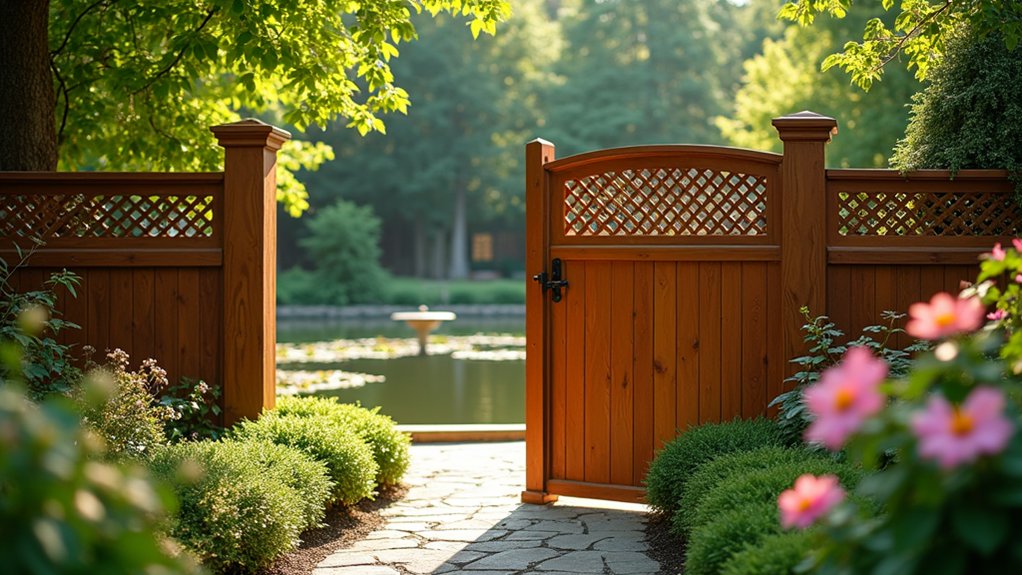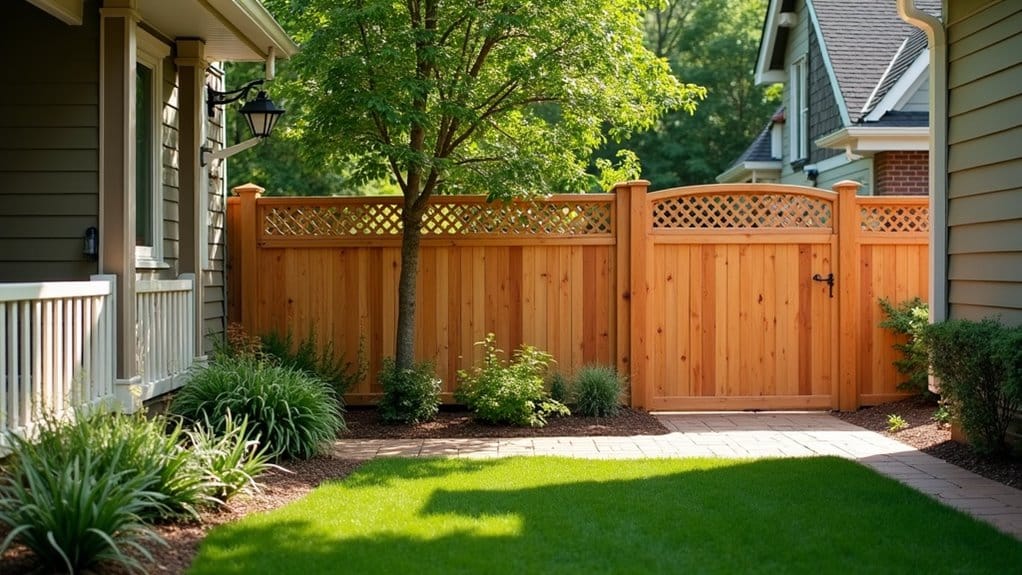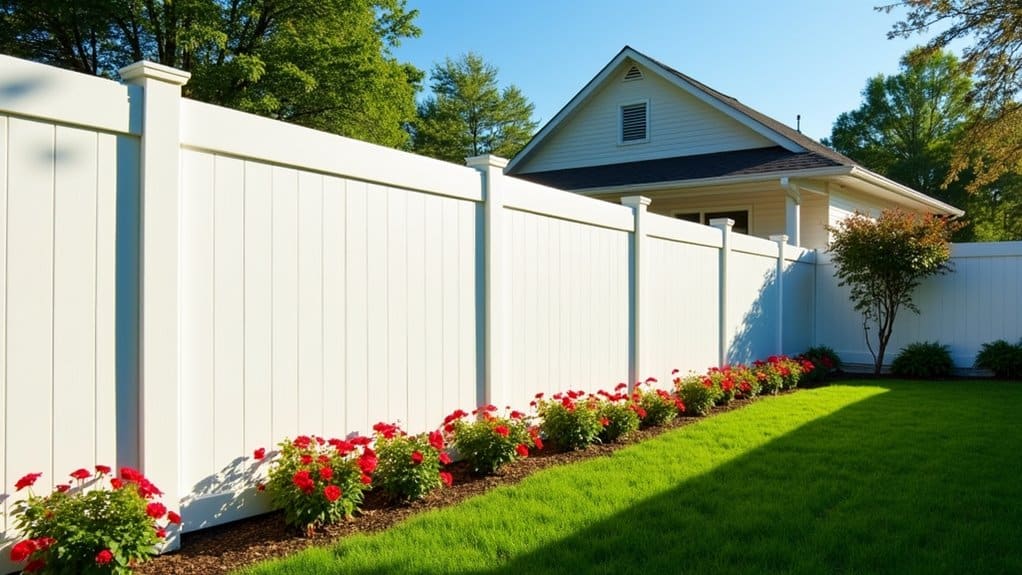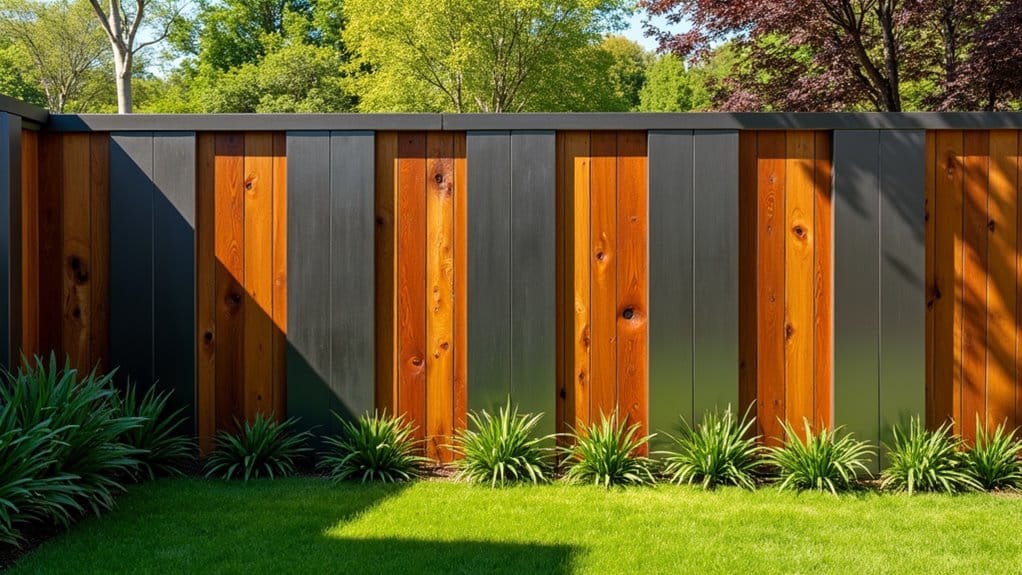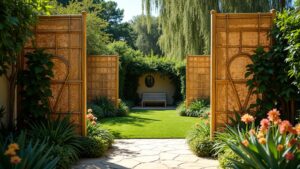Tailoring custom fences to fit your landscape design can truly enhance your yard. Choose finishes that complement your materials, like warm cedar stains for a natural look or sleek aluminum for a modern vibe. Match colors with your plants for added visual interest, and mix materials for a unique touch. Think about your yard’s layout and what you need from each space, whether it’s privacy or openness. There are countless design options to elevate your property and make it feel more cohesive.
Key Takeaways
- Select fence colors that either complement or contrast with your garden plants using the color wheel to achieve a unified look.
- Choose eco-friendly or mixed materials for your fence to boost sustainability and visual appeal.
- Design the fence layout to follow the natural terrain, enhancing views and creating distinct areas for various activities.
- Pair fence styles with their purpose: opt for tall fences for privacy and decorative options for ornamental gardens.
- Consider integrating smart technology for added security and convenience while keeping the design cohesive with your landscape.
Understanding Custom Finishes for Fences
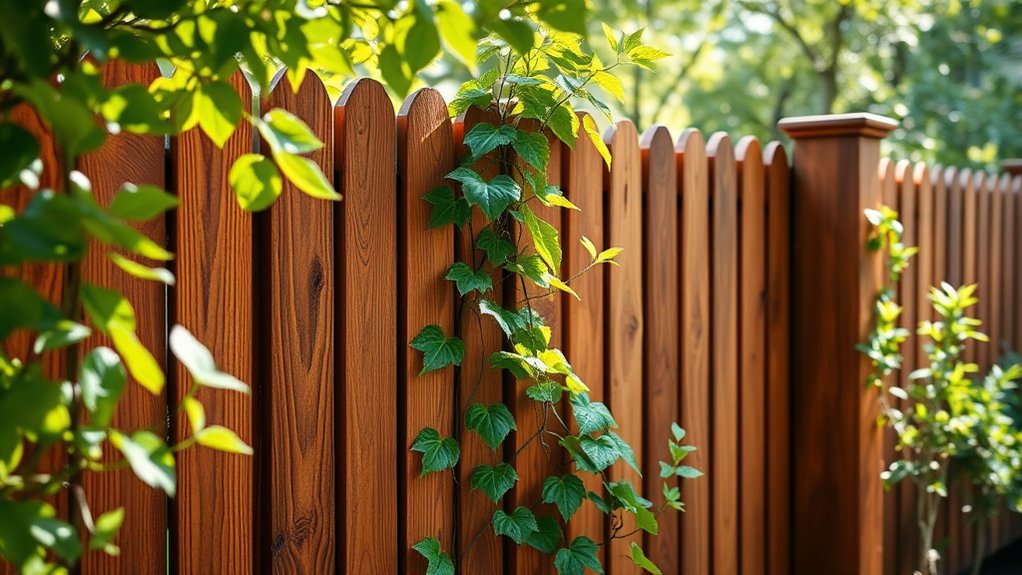
When choosing a custom fence for your property, understanding the different finishes is essential. Each material impacts both appearance and durability.
For example, a cedar fence paired with a warm stain enhances its natural beauty and fits well with your landscape. Wrought iron offers elegance and strength, while aluminum is lightweight and rust-resistant, ideal for any climate. Additionally, selecting the right material can significantly affect the durability and maintenance of your fence. Wood fences, while offering a classic look, often require more regular upkeep compared to vinyl options.
If you’re looking for low maintenance, vinyl is durable against harsh weather, and composite materials give you the look of wood without the upkeep.
Choosing the right finish not only improves the fence’s appearance but also extends its lifespan, ensuring it remains a beautiful boundary for years.
Integrating Fences With Landscape Design

Integrating fences into your landscape can greatly enhance your outdoor space. Choosing colors that match your garden can create a unified look. For example, a wooden fence stained to match your patio or garden furniture can pull everything together. A well-planned layout ensures that your fence not only marks boundaries but also adds to the overall beauty of your yard. Additionally, consider using mixed materials fencing to achieve a unique aesthetic that complements your landscape design. Incorporating eco-friendly materials can further enhance the sustainability of your outdoor space while adding visual appeal.
Color Harmonization Techniques
Color harmonization techniques are key to blending fences with your landscape design, making your outdoor space inviting.
Start with the color wheel to find complementary hues between your fence and plants. For a striking look, pair bold fence colors with soft flowers for a dramatic contrast.
Choose fence colors that match the seasonal blooms in your garden—like earthy browns for woodland areas or vibrant reds for lively landscapes. Consider using fence landscaping to enhance the overall aesthetic and attract beneficial pollinators. Additionally, design compatibility is crucial when selecting fence colors to ensure they resonate with your home’s exterior theme.
Softer fence colors can merge nicely with greenery, softening boundaries and enhancing your garden’s appeal.
These strategies help create a cohesive outdoor environment that showcases your personal style.
Layout Planning Strategies
When integrating fences into your landscape design, careful layout planning is crucial for a cohesive outdoor space. Start by assessing the terrain to identify slopes, obstacles, and appealing views. Position your fence to align with these features for optimal effect.
Define areas based on their purpose by choosing suitable fence styles:
| Zone Type | Fence Style | Purpose |
|---|---|---|
| Privacy Areas | Tall, solid fences | Create secluded spaces |
| Ornamental Gardens | Decorative, open styles | Enhance planting beds |
| Service Zones | Sturdy materials | House storage and utilities |
| Entertainment Spaces | Low, see-through fences | Foster open social areas |
This strategic approach ensures both aesthetic appeal and functionality in your design.
Embracing Technological Advancements in Fencing
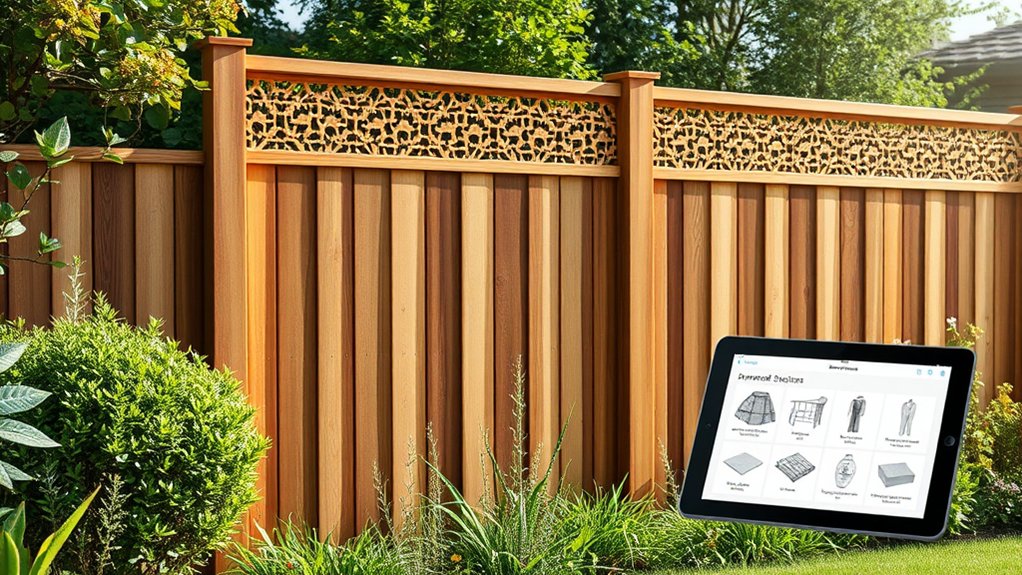
In today’s world, blending security with innovation in fencing can greatly enhance your property’s safety and appeal.
Imagine installing smart sensors in eco-friendly materials like composite vinyl or reclaimed wood. These can create an attractive barrier that monitors your perimeter around the clock. Motion and vibration detectors send you instant alerts for unauthorized access, while AI technology helps reduce false alarms by distinguishing between wildlife and real threats.
Automated gates that you can control from your smartphone add convenience. Plus, modular designs let you customize features to fit your landscape.
Balancing Functional and Aesthetic Elements
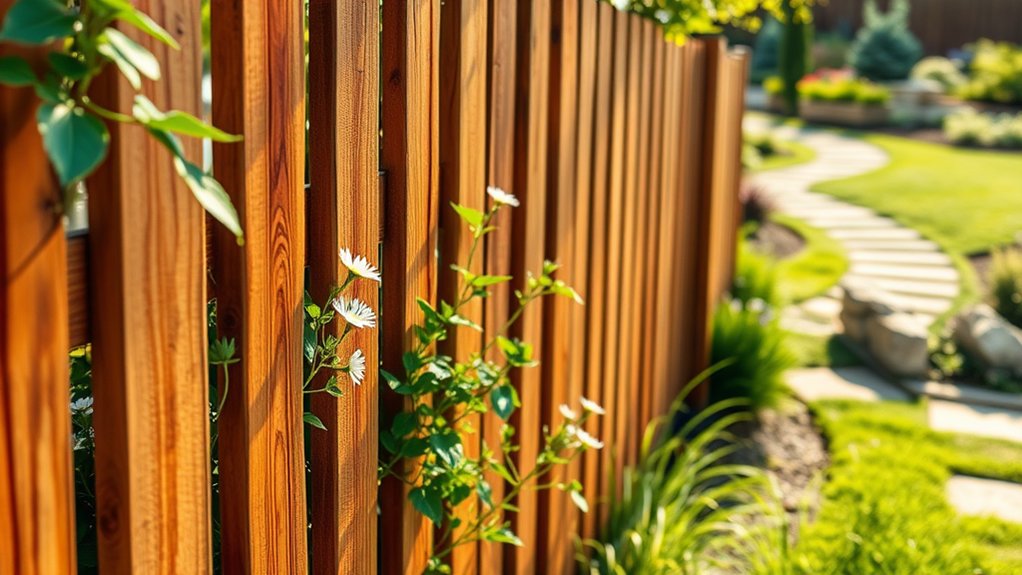
When designing your outdoor space, it’s important to balance function and aesthetics. Your fence should serve as a boundary while also looking good.
Choose durable materials like weathered wood or sleek metal that fit your landscape. Consider how your fence can create separate areas for relaxation or play, and think about adding climbing plants for extra greenery.
Analyzing Market Trends in Landscape Design

Designing your outdoor space goes beyond aesthetics; it’s about adapting to current landscape design trends. Sustainable landscaping is key—using native plants boosts biodiversity and requires less maintenance, creating a healthier environment.
| Trend | Description |
|---|---|
| Sustainable Practices | Focus on native plants and wildlife habitats |
| Low-Maintenance Design | Incorporate hardscaping and automated systems |
| Natural Aesthetics | Combine organic shapes with varied plant species |
Effective Planning and Execution for Fence Installation

Effective planning and execution are key to a successful fence installation. First, decide why you need the fence—whether for privacy, security, or decoration. Check local regulations for height and materials to ensure compliance. Measure your space carefully to determine how many posts you’ll need.
Next, mark the fence line, clear the area, and dig post holes, adding gravel for drainage. When installing the posts, make sure each one is level and secure them with concrete.
Finally, attach the rails and panels, making any necessary adjustments for slopes. With good planning and execution, your fence won’t only function well but also enhance your outdoor space.
Frequently Asked Questions
What Are the Most Popular Fence Materials for Landscaping?
When selecting fence materials for landscaping, consider wood for its natural beauty versus vinyl for its low maintenance. Metal fencing provides durability and security, fitting nicely into your design and enhancing your outdoor space’s look.
How Can I Customize My Fence Color?
Customize your fence color to enhance your outdoor space! Consider how colors affect mood—bright hues can energize, while softer tones create calm. With various stain options available, you can easily find a shade that matches your vision, making your yard a beautiful retreat.
What Are the Best Plants to Pair With Fences?
To improve your fence’s look, consider climbing plants like hydrangeas or roses for vibrant coverage. Pair them with hardy shrubs and ornamental grasses for added texture and privacy. This combination can turn your fence into a beautiful focal point in your yard.
How Do I Maintain My Fence’s Appearance Over Time?
To maintain your fence’s appearance, clean it regularly and inspect for damage. Remove dirt and grime with a scrub brush, check for any wear or rot, and apply protective stains as needed. This simple upkeep will keep your fence looking great all year round!
Are There Eco-Friendly Fence Options Available?
Yes, there are eco-friendly fence options! You can use sustainable materials like bamboo or reclaimed wood. These biodegradable choices not only enhance your outdoor space but also support the environment, creating a beautiful fence that blends seamlessly with nature.
Conclusion
When adding a custom fence to your landscape, think of it as a frame for a painting—it sets boundaries while enhancing the overall view. Your choices reflect your style, turning a simple barrier into a creative expression. Just like your garden, your fence should blend with the surroundings, combining strength and aesthetics. This balance of design and function creates a space that not only serves a purpose but also reflects your unique vision.

